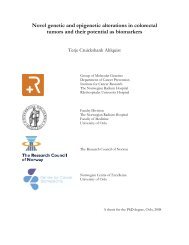Preface - Ous-research.no
Preface - Ous-research.no
Preface - Ous-research.no
Create successful ePaper yourself
Turn your PDF publications into a flip-book with our unique Google optimized e-Paper software.
Experimental Orthopaedic Research<br />
defect in the knee and the consequence this might have for<br />
the treatment of defect and risk of degenerative changes.<br />
One experimental study has been performed to specifically<br />
investigate this issue and the location is essential as shown<br />
in the current study. The difference in the outcome between<br />
microfracture and mosaicplasty has been difficult to<br />
evaluate clinically and an experimental study has been conducted<br />
to evaluate these clinically techniques. Changes are<br />
observed in the subchondral bone that is of concern for the<br />
long-term risk of degenerative changes in the joint. Mesenchymal<br />
stem cells implanted under a commercially available<br />
scaffold for repair of articular defect have been evaluated<br />
experimentally to look at feasibility of this technique and<br />
the amount of cartilage obtained in the defect.<br />
Clinical projects<br />
The experimental work is close connected to the clinical<br />
studies of the group and there is an ongoing study on stem<br />
cell treatment versus chondrocyte implantation. Patients<br />
with cartilage defects of the knees treated with chondrocyte<br />
implantation have been evaluated with electron microscopy<br />
biopsies to look at ultra organization of the tissue and<br />
deaths of chondrocytes in a recent publication.<br />
Deficient fracture healing<br />
Delayed fracture healing or <strong>no</strong>n-union may occur in patients<br />
with systemic diseases, with hormonal or nutritional<br />
deficiencies, or in patients taking specific medications like<br />
<strong>no</strong>n-steroidal anti-inflammatory drugs (NSAIDs and CO-<br />
XIBS). NSAIDs have been reported in general to affect bone<br />
metabolism, and indometacin has been shown to reduce<br />
fracture healing experimentally, and to inhibit ectopic bone<br />
formation clinically.<br />
In these studies we have investigate fracture healing in rats<br />
on a short time medication with an injectible COX-2-inhibitors,<br />
and in rats made severely osteoporotic by estrogen and<br />
vitaminD 3<br />
depletion. Parecoxib is a new and selective NSAID<br />
targeting cyclooxygenase-2 (COX-2). Through their selective<br />
action these drugs are supposed to lack many of the main<br />
side effects of other NSAIDs and thereby, expected to be<br />
drugs of choice in near future for several patient groups. The<br />
effects on bone metabolism and healing have, however, <strong>no</strong>t<br />
been elucidated. Furthermore, it is demonstrated that COX-<br />
2 is required for both intramembra<strong>no</strong>us and endochondral<br />
bone formation. Thus there are reasons to concern regarding<br />
the potential negative effects of these drugs on bone<br />
metabolism and bone repair. Concern has been expressed<br />
about its potential negative effects on bone. The present<br />
study was designed to investigate the effects of short-term<br />
administration of parecoxib on bone healing. Based on the<br />
current k<strong>no</strong>wledge our hypothesis is that the drug will delay<br />
the healing process and this is verified and published.<br />
A<strong>no</strong>ther project on intramedullary nailing and external fixation<br />
in lower leg fractures evaluates bone healing by quantitative<br />
micro computer tomography (qmCT), in addition<br />
to mechanical testing and densitometric measurements.<br />
This includes development of a segmentation technique<br />
applied to qmCT images and an investigation of correlation<br />
between the segmented qmCT data and mechanical properties.<br />
The group documents the efforts and results made<br />
in these <strong>no</strong>vel projects in a recent publication This work is<br />
soon to be finalize in the PhD defense scheduled to the 11th<br />
March 2011, by one of the group members Ulf W Sigurdsen.<br />
Allograft is important both in bony defects as well as in arthroscopic<br />
surgery and experimental work on the biological<br />
events of allograft is recently published.<br />
Tendon healing to bone surfaces/tunnels<br />
Healing of tendon material to bony surfaces is of major<br />
importance in both shoulder and knee surgery where<br />
understanding of the biology and biomechanics in this<br />
process is a key element. A recent experimental paper from<br />
the group demonstrates that this is significantly affected by<br />
COX-2-inhibitors.<br />
PhD-dissertations<br />
There was two PhD-dissertations in 2010 based on the work<br />
from the recent years by consultant Sverre Løken concerning<br />
cartilage injuries and Sigbjørn Dimmen on the effects<br />
on NSAIDS in fracture and tendon healing. In May 2011<br />
a<strong>no</strong>ther of the group members (Stig Heir) will fullfill his PhD<br />
dissertation. Furthermore the fracture <strong>research</strong> soon will<br />
be fulfilled with the PhD disseratation March 2011 of Ulf W.<br />
Sigurdsen.<br />
Figure 1. Cartilage defect treated with a chondrocytes loaded<br />
scaffold<br />
30
















